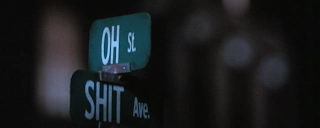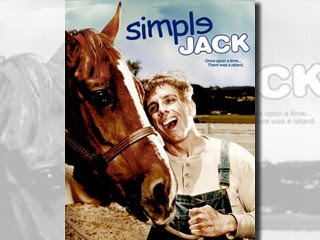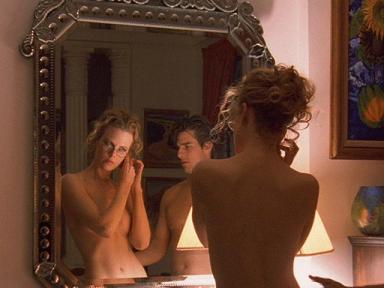A Look at "The Dark Knight" Script

I must say, this may very well be the best script of the year.
The Dark Knight is 167 pages, all of which flies by just as quickly as the 2 ½ hour film. Everything that’s great about the film is evident on the page. The Nolan brothers are entirely focused on their story. They’re relentless about the tension, suspense, and inner conflicts, while also being thoroughly professional about the script’s presentation. There are no distractions on the page, like bad grammar or bad format. It’s so polished that once you’re sucked into the story, they keep you there without letting your mind get kicked offline with hiccups like poor grammar, which reminds you that you’re only reading a screenplay. When you read DK, you are in that world and you will stay there until the story’s over. Nolan reminds me of Anthony Minghella in the sense that he’s a writer-director that refuses to inject into his scripts all kinds of technical details like camera angles and transitions.
On the page, it’s ALL about story.
So let me ask a question. How would you write the opening shot of the film? You may recall the glorious Imax-inspired view of the city and the slow zoom in on one building, then one window, which shatters. How do you write that without camera angles or "we see?" Here you go:
DAYLIGHT. Moving over the towers of downtown Gotham… Closing in on an office building… On a large window… which shatters to reveal -
INT. OFFICE, HIGH RISE – DAY
A man in a CLOWN MASK holding a SMOKING SILENCED PISTOL ejects a shell casing. This is DOPEY. He turns to a second man, HAPPY, also in a clown mask, who steps forward with a CABLE LAUNCHER, aims at a lower roof across the street and FIRES a cable across. Dopey secures the line to an I-beam line – CLAMP on – sends a KIT BAG out then steps OUT the window…
EXT. HIGH-RISE – DAY
…into space. The men SLIDE across the DIZZYING DROP… landing on the lower roof across the street.
I love it! “Moving over the towers of downtown Gotham… Closing in on an office building… On a large window… which shatters…” I’ll take that. The camera directions are implied. No technical details like “zoom in” and “angle on.” No “we see.” The ellipsis implies the time that goes by as we slowly move toward the window in one take. And the words inspire the imagination with a visual vocabulary that places the mind’s eye over the city of Gotham and flying toward a window. And you’re immediately sucked in because you know something not so nice is about to happen in the city of Gotham led by the Joker.

Consider this sequence, which was cut. This shows us how Bruce arrived in Hong Kong and would’ve followed Fox’s business meeting.
INT. HOLD, C-130 CARGO HAULER – DAWN
Two SMUGGLERS steal glances at Wayne, crouched at the rear in balaclava and flight suit. The COPILOT signals Wayne, who pulls on his oxygen mask and stands up. The rear of the plane OPENS. Wayne steps to the edge, then JUMPS.
EXT. SKIES ABOVE HONG KONG – DAWN
Moving across the water toward Hong Kong harbor…
A tiny figure drops into frame, PLUMMETING towards the water – SPEEDING past the highest floors of skyscrapers, seconds from impact. Wayne PULLS the chute – DROPS into the water…
EXT. BENEATH FREEWAY, HONG KONG HARBOR – DAY
Wayne pulls himself out of the water, dragging up his pack.
This would’ve been followed by the scene where Wayne and Fox meet, and Fox shows him his special sonar cell phone.

Consider this Hong Kong rooftop scene, similar to the opening shot.
EXT. HONG KONG – NIGHT
Moving toward the tallest building in the glittering skyline to find Wayne, crouched on the roof. The blades of his gauntlets CLICK into place. He dons the helmet-like cowl. His “cape” is in the form of a hard faceted PACK.
He stands – pulls two black boxes from his belt, CLICKS them together and UNFOLDS them into a RIFLE-LIKE DEVICE. Batman SCOPES a second, lower building. Adjust a setting and FIRES – four times…
Four small STICKY BOMBS SLAP onto the glass of the lower building. They have visible timers which are COUNTING DOWN.

Here’s where he leaps off the building.
EXT. ROOFTOP OVERLOOKING L.S.I. HOLDINGS
Batman LAUNCHES into the glittering night, DROPPING from the tall tower… his pack BURSTS OPEN, becoming his BAT WINGS – he GLIDES down to the lower building, STREAKING around it, BANKING HARD to line up with a window in the rear…
INT. LAU’S OFFICE, L.S.I. HOLDINGS – NIGHT
Lau is talking on the phone, staring at a profit projection on a flat screen monitor. Suddenly, the room goes dark.
EXT. L.S.I. HOLDINGS – CONTINUOUS
As Batman HURTLES towards the glass he collapses his wings, WRAPPING his cape around himself and CANNONBALLING THROUGH THE GLASS –
INT. LAU’S OFFICE SUITE, L.S.I. HOLDINGS – NIGHT
- ROLLING across the floor in a flurry of broken glass…
I look at these sequences and think about how wordy amateur scripts would’ve been to describe the same thing. I usually switch between pro and amateur scripts and the differences are stunning. Pro scripts can have problems with stories just like amateur scripts but they always move quicker. Amateurs too often think small and move too slow while describing incidentals, like room descriptions and the slightest gestures of characters while they have conversations. With the Nolan brothers, only the most essential details were incorporated into the script. They didn’t have time to dilly-dally with slight gestures or room descriptions. They kept it moving. And it’s totally engrossing. There’s something to be said about explaining EVERYTHING vs. explaining JUST ENOUGH to spark the imagination of the reader.

Above is early concept work of the Joker from a DK production book.
There weren’t too many changes from what was on the page to what was in the finished film. In the opening bank heist sequence, the script did not give us the big close-up of Joker’s face as we saw in the film. Instead, when the Joker said his line and took off his clown mask, the script called for a shot of the Bank Manager gasping at the site of his face, but we would only see reflections of different parts of the Joker's grotesque face on the glass debris on the floor lying all around the Bank Manager. Of course, the close-up feels right.

In the fancy restaurant scene, you may recall that Dent told Rachel it took him three weeks to get a reservation and he had to tell them he works for the government. Well, there are two lines that were cut in the exchange between Bruce, Rachel, and Dent, when Bruce crashed their date, which revealed the fact that Rachel knew Bruce was jealous of Dent and actively trying to sabotage their dates.
Wayne: Let’s put a couple of tables together.
Dent: I don’t know if they’ll let us –
Wayne: They should. I own the place.
Rachel: For how long? About three weeks?
Wayne: How’d you know?
The whole point of Dent saying it took him three weeks was to setup the joke that Wayne bought the restaurant three weeks ago just to give Dent a really hard time when it comes to dating Rachel.
 I’d like to mention the scene where the Joker crashed the meeting of the mobsters with Lau in that hotel kitchen. In the finished film, the scene’s perfection. But the way the scene played out in the script was different and off. In the film, you had the meeting. You had Lau on a TV screen explaining how he moved all their money without telling them, which is intercut with shots of Gordon and the police trying to seize the funds only to find the money gone. Then, the Joker enters, changes the dynamics of the situation, and the scene ends with a shot of him backing out of the kitchen with all those explosives. In the script, we had the meeting, just like the film. We had Lau on a TV screen explaining how he moved the money, which is interrupted by the Joker who makes a different proposition about Batman. Then he leaves and says, “Let me know when you change your minds.” The mobsters turn back to Lau who finishes talking about the money, which is intercut with shots of Gordon and the police. That doesn’t work. It devalues the Joker’s influence. Plus, a scene has to be a shift in values of some kind. It starts on one value and ends on a different one. Once the Joker arrives, the dynamics of the whole situation changes, and the emphasis should be on him at the end of the scene.
I’d like to mention the scene where the Joker crashed the meeting of the mobsters with Lau in that hotel kitchen. In the finished film, the scene’s perfection. But the way the scene played out in the script was different and off. In the film, you had the meeting. You had Lau on a TV screen explaining how he moved all their money without telling them, which is intercut with shots of Gordon and the police trying to seize the funds only to find the money gone. Then, the Joker enters, changes the dynamics of the situation, and the scene ends with a shot of him backing out of the kitchen with all those explosives. In the script, we had the meeting, just like the film. We had Lau on a TV screen explaining how he moved the money, which is interrupted by the Joker who makes a different proposition about Batman. Then he leaves and says, “Let me know when you change your minds.” The mobsters turn back to Lau who finishes talking about the money, which is intercut with shots of Gordon and the police. That doesn’t work. It devalues the Joker’s influence. Plus, a scene has to be a shift in values of some kind. It starts on one value and ends on a different one. Once the Joker arrives, the dynamics of the whole situation changes, and the emphasis should be on him at the end of the scene.One other change in this scene is that we would’ve learned the money the Joker acquired from the bank heist helped buy his new purple suit. Maroni told Lau that the Joker was just a “two-bit whack job” that “wears a cheap purple suit and make-up.” When the Joker enters later and does the pencil trick, he says to Maroni, “And by the way, the suit wasn’t cheap. You should know. You bought it.” Hehehe…
 There was also a change in the timing of when Dent reveals his face in the hospital room. In the script, Dent shows his face in the middle of the scene. In the finished film, they moved the dialogue around to let him reveal his face toward the end of the scene, which is better. Scenes are setups and payoffs. Save the payoffs for the end of the scene.
There was also a change in the timing of when Dent reveals his face in the hospital room. In the script, Dent shows his face in the middle of the scene. In the finished film, they moved the dialogue around to let him reveal his face toward the end of the scene, which is better. Scenes are setups and payoffs. Save the payoffs for the end of the scene.Do you know how much money was in that cargo hold – a billion dollars, which the script described as thirty feet high.

Three other impressions from the script:
1) The Joker wasn’t crazy for the sake of being crazy. They gave him a clear philosophical world view that defined who he was and why he did what he did, which found its origins in The Killing Joke. Plus, the dialogue for the Joker is such a great reminder to new writers that you have to give actors a chance to really act through the dialogue.
2) The Nolans have a kind of magician’s approach to holding our attention in a story, like the pencil trick. What’s he talking about? How is he going to make the pencil disappear? Then, payoff. Or that scene in the Pool Hall where Gambol was told they have the Joker’s dead body. You know perfectly well the Joker’s not dead, but you keep watching because you have questions. Who’s in the bag? What’s the trick? How is the Joker going to act? What’s going to happen? Of course, you ask that with just about any evil scenario the Joker created, too, because you’re curious about how it’s going to play out. Creating questions in the minds of your readers makes them want to continue reading. It's the oldest trick in writing.
3) The tension and suspense are still the best elements of the film. Consider all the ways time was used to heighten the suspense. Every day Batman fails to reveal himself, people will die. Then, we’d know who was the target and we'd keep watching because we’re curious if or how the Joker will get to that target. “Depending on the time, he might be in one spot… or several.” He had “just minutes left” to save either Rachel or Dent. The way the Joker parceled out crucial information about his new game quickly heightened the tension in that interrogation scene with Batman. Then there was the commercial – tonight at five o’clock, we’ll reveal the identity of Batman. Stay tuned. Or the Joker’s phone call – “If Coleman Reese isn’t killed in sixty minutes, I’m going to blow up a hospital.” Or the ferry situation – If you don’t blow-up the other ferry by midnight, I’ll blow-up both of your ferries.
Thanks to Mr. Daniel Cova for sharing with me The Dark Knight (and a few other) scripts. While this spec’s not available yet, I have no doubt that the script for a film this popular will eventually hit the web.
-MM
































